University Assignment: Collaborative Partnerships and Relationships
VerifiedAdded on 2022/10/12
|5
|915
|247
Homework Assignment
AI Summary
This assignment solution delves into the intricacies of collaborative partnerships and relationships. It addresses key legal requirements such as Memorandums of Understanding, profit sharing, asset sharing, licensing, and taxation. The document identifies essential information needed when forming partnerships, including the reasons for collaboration, business positions, and management structures. It outlines resource planning, including financial, technical, and physical resources, and explores issues that partnership policies and procedures address, such as employee behavior, selection of actions, violation consequences, protection, and legal compliance. Finally, it considers the factors involved in establishing reporting systems to evaluate partnership outcomes, emphasizing the importance of assessing desired outcomes and impacts. The solution is supported by references to relevant academic sources.
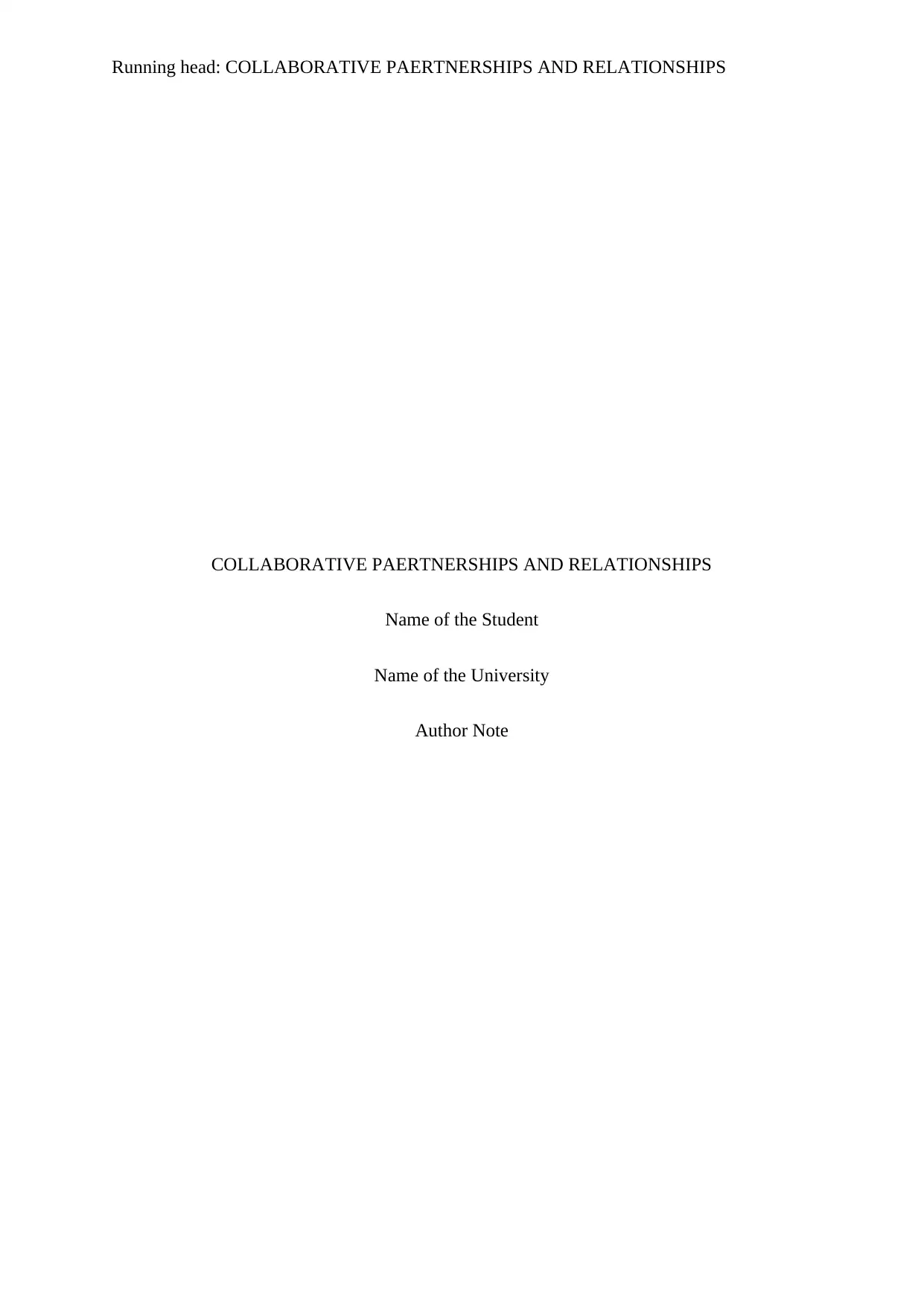
Running head: COLLABORATIVE PAERTNERSHIPS AND RELATIONSHIPS
COLLABORATIVE PAERTNERSHIPS AND RELATIONSHIPS
Name of the Student
Name of the University
Author Note
COLLABORATIVE PAERTNERSHIPS AND RELATIONSHIPS
Name of the Student
Name of the University
Author Note
Paraphrase This Document
Need a fresh take? Get an instant paraphrase of this document with our AI Paraphraser
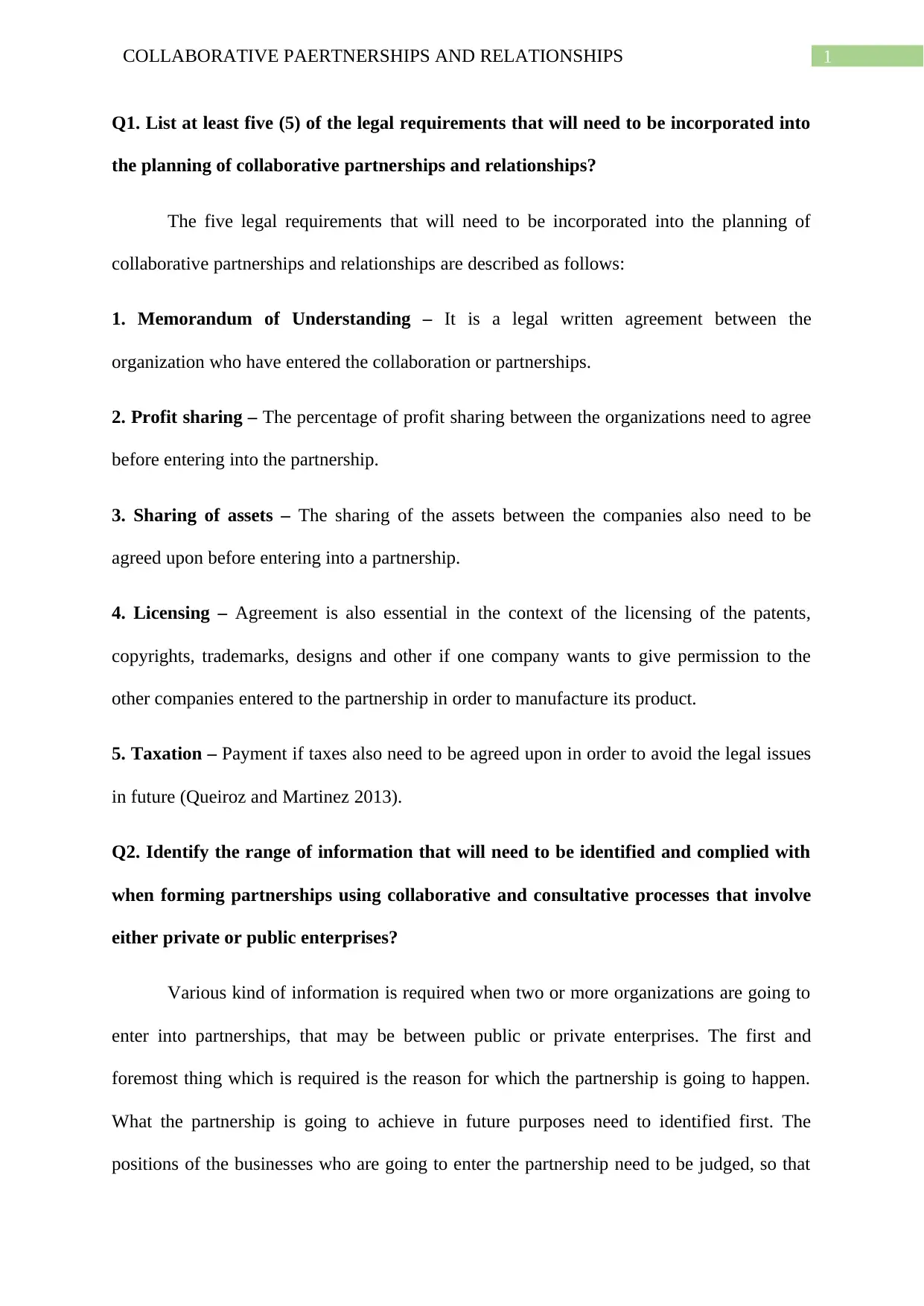
1COLLABORATIVE PAERTNERSHIPS AND RELATIONSHIPS
Q1. List at least five (5) of the legal requirements that will need to be incorporated into
the planning of collaborative partnerships and relationships?
The five legal requirements that will need to be incorporated into the planning of
collaborative partnerships and relationships are described as follows:
1. Memorandum of Understanding – It is a legal written agreement between the
organization who have entered the collaboration or partnerships.
2. Profit sharing – The percentage of profit sharing between the organizations need to agree
before entering into the partnership.
3. Sharing of assets – The sharing of the assets between the companies also need to be
agreed upon before entering into a partnership.
4. Licensing – Agreement is also essential in the context of the licensing of the patents,
copyrights, trademarks, designs and other if one company wants to give permission to the
other companies entered to the partnership in order to manufacture its product.
5. Taxation – Payment if taxes also need to be agreed upon in order to avoid the legal issues
in future (Queiroz and Martinez 2013).
Q2. Identify the range of information that will need to be identified and complied with
when forming partnerships using collaborative and consultative processes that involve
either private or public enterprises?
Various kind of information is required when two or more organizations are going to
enter into partnerships, that may be between public or private enterprises. The first and
foremost thing which is required is the reason for which the partnership is going to happen.
What the partnership is going to achieve in future purposes need to identified first. The
positions of the businesses who are going to enter the partnership need to be judged, so that
Q1. List at least five (5) of the legal requirements that will need to be incorporated into
the planning of collaborative partnerships and relationships?
The five legal requirements that will need to be incorporated into the planning of
collaborative partnerships and relationships are described as follows:
1. Memorandum of Understanding – It is a legal written agreement between the
organization who have entered the collaboration or partnerships.
2. Profit sharing – The percentage of profit sharing between the organizations need to agree
before entering into the partnership.
3. Sharing of assets – The sharing of the assets between the companies also need to be
agreed upon before entering into a partnership.
4. Licensing – Agreement is also essential in the context of the licensing of the patents,
copyrights, trademarks, designs and other if one company wants to give permission to the
other companies entered to the partnership in order to manufacture its product.
5. Taxation – Payment if taxes also need to be agreed upon in order to avoid the legal issues
in future (Queiroz and Martinez 2013).
Q2. Identify the range of information that will need to be identified and complied with
when forming partnerships using collaborative and consultative processes that involve
either private or public enterprises?
Various kind of information is required when two or more organizations are going to
enter into partnerships, that may be between public or private enterprises. The first and
foremost thing which is required is the reason for which the partnership is going to happen.
What the partnership is going to achieve in future purposes need to identified first. The
positions of the businesses who are going to enter the partnership need to be judged, so that
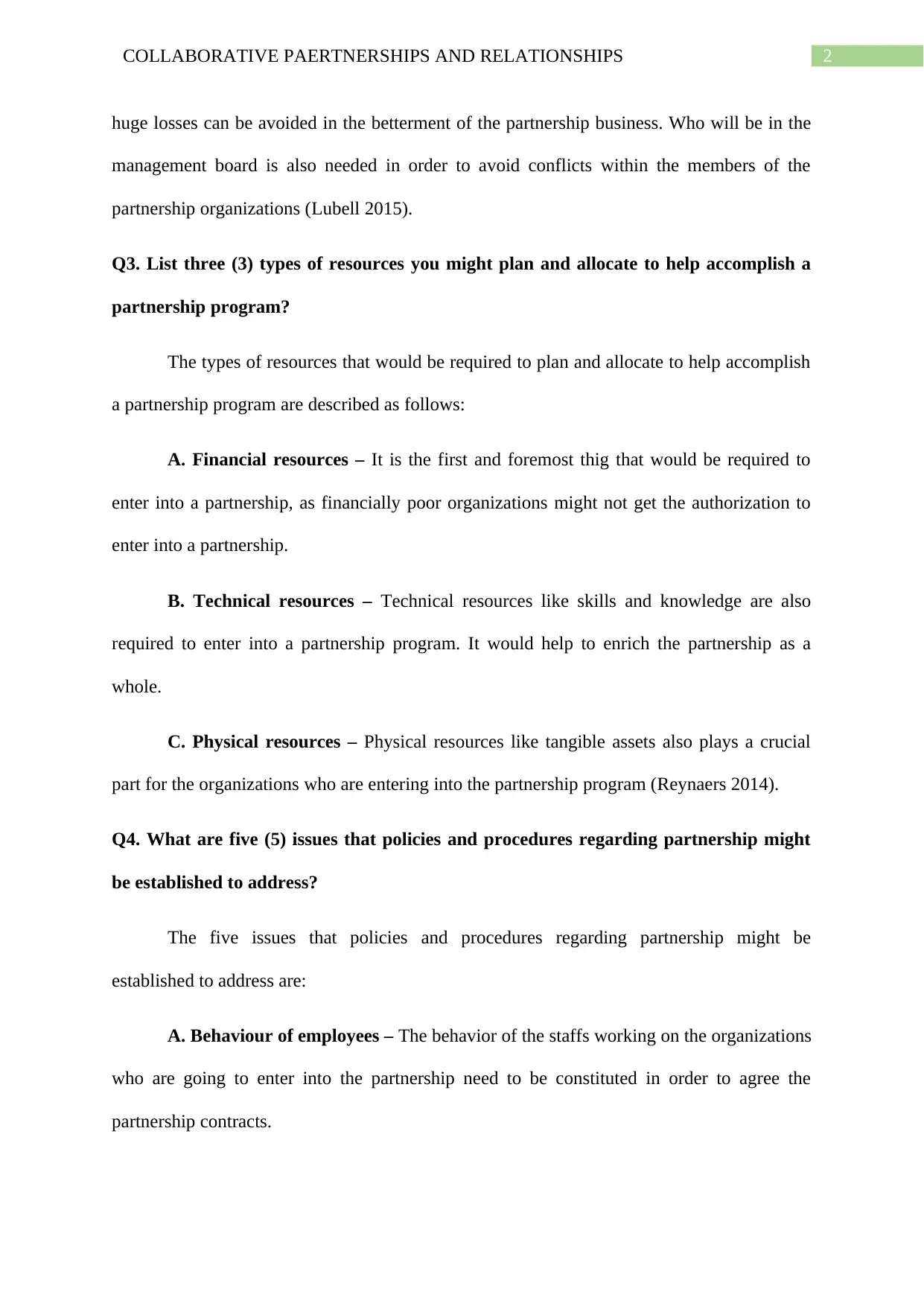
2COLLABORATIVE PAERTNERSHIPS AND RELATIONSHIPS
huge losses can be avoided in the betterment of the partnership business. Who will be in the
management board is also needed in order to avoid conflicts within the members of the
partnership organizations (Lubell 2015).
Q3. List three (3) types of resources you might plan and allocate to help accomplish a
partnership program?
The types of resources that would be required to plan and allocate to help accomplish
a partnership program are described as follows:
A. Financial resources – It is the first and foremost thig that would be required to
enter into a partnership, as financially poor organizations might not get the authorization to
enter into a partnership.
B. Technical resources – Technical resources like skills and knowledge are also
required to enter into a partnership program. It would help to enrich the partnership as a
whole.
C. Physical resources – Physical resources like tangible assets also plays a crucial
part for the organizations who are entering into the partnership program (Reynaers 2014).
Q4. What are five (5) issues that policies and procedures regarding partnership might
be established to address?
The five issues that policies and procedures regarding partnership might be
established to address are:
A. Behaviour of employees – The behavior of the staffs working on the organizations
who are going to enter into the partnership need to be constituted in order to agree the
partnership contracts.
huge losses can be avoided in the betterment of the partnership business. Who will be in the
management board is also needed in order to avoid conflicts within the members of the
partnership organizations (Lubell 2015).
Q3. List three (3) types of resources you might plan and allocate to help accomplish a
partnership program?
The types of resources that would be required to plan and allocate to help accomplish
a partnership program are described as follows:
A. Financial resources – It is the first and foremost thig that would be required to
enter into a partnership, as financially poor organizations might not get the authorization to
enter into a partnership.
B. Technical resources – Technical resources like skills and knowledge are also
required to enter into a partnership program. It would help to enrich the partnership as a
whole.
C. Physical resources – Physical resources like tangible assets also plays a crucial
part for the organizations who are entering into the partnership program (Reynaers 2014).
Q4. What are five (5) issues that policies and procedures regarding partnership might
be established to address?
The five issues that policies and procedures regarding partnership might be
established to address are:
A. Behaviour of employees – The behavior of the staffs working on the organizations
who are going to enter into the partnership need to be constituted in order to agree the
partnership contracts.
⊘ This is a preview!⊘
Do you want full access?
Subscribe today to unlock all pages.

Trusted by 1+ million students worldwide
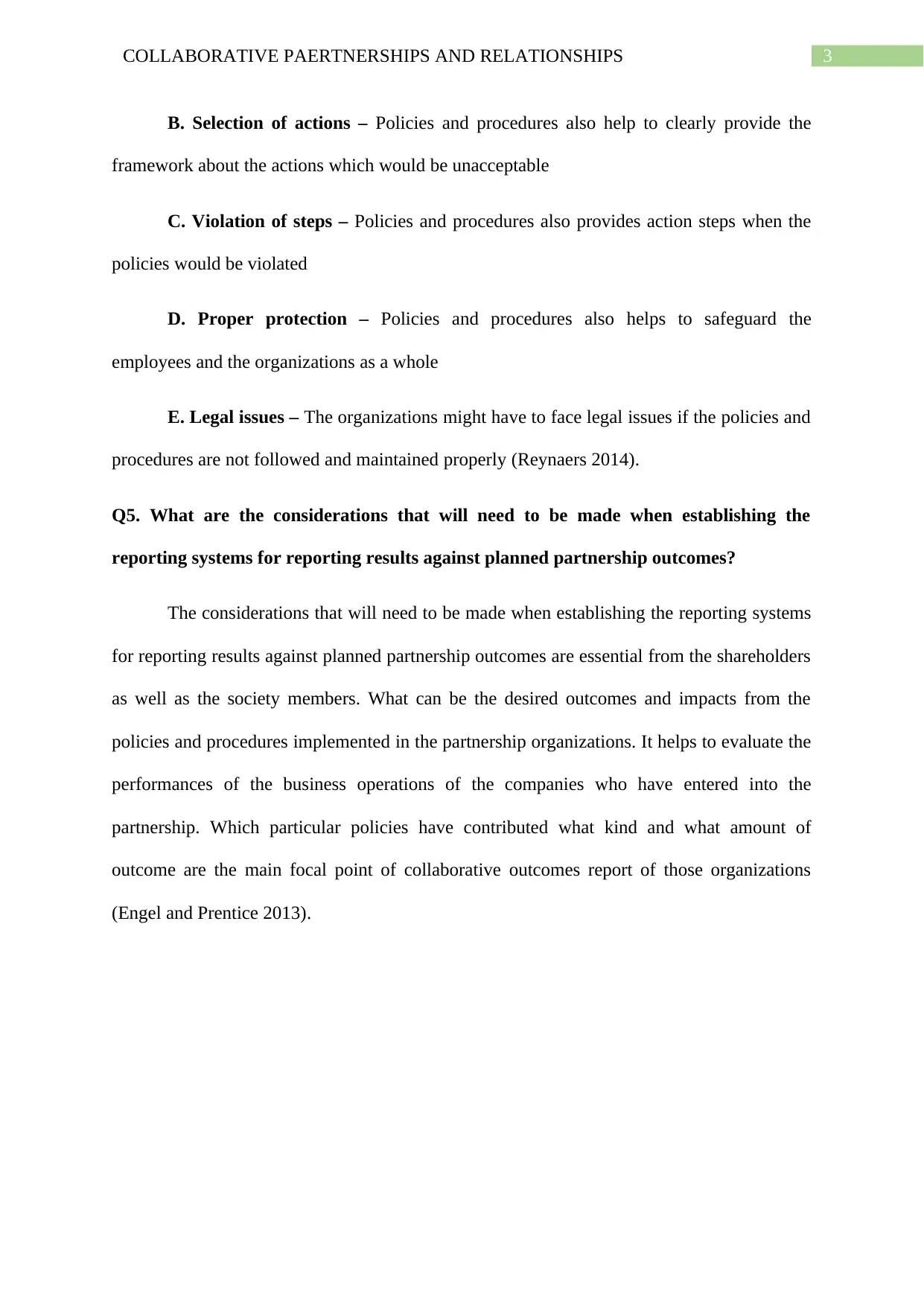
3COLLABORATIVE PAERTNERSHIPS AND RELATIONSHIPS
B. Selection of actions – Policies and procedures also help to clearly provide the
framework about the actions which would be unacceptable
C. Violation of steps – Policies and procedures also provides action steps when the
policies would be violated
D. Proper protection – Policies and procedures also helps to safeguard the
employees and the organizations as a whole
E. Legal issues – The organizations might have to face legal issues if the policies and
procedures are not followed and maintained properly (Reynaers 2014).
Q5. What are the considerations that will need to be made when establishing the
reporting systems for reporting results against planned partnership outcomes?
The considerations that will need to be made when establishing the reporting systems
for reporting results against planned partnership outcomes are essential from the shareholders
as well as the society members. What can be the desired outcomes and impacts from the
policies and procedures implemented in the partnership organizations. It helps to evaluate the
performances of the business operations of the companies who have entered into the
partnership. Which particular policies have contributed what kind and what amount of
outcome are the main focal point of collaborative outcomes report of those organizations
(Engel and Prentice 2013).
B. Selection of actions – Policies and procedures also help to clearly provide the
framework about the actions which would be unacceptable
C. Violation of steps – Policies and procedures also provides action steps when the
policies would be violated
D. Proper protection – Policies and procedures also helps to safeguard the
employees and the organizations as a whole
E. Legal issues – The organizations might have to face legal issues if the policies and
procedures are not followed and maintained properly (Reynaers 2014).
Q5. What are the considerations that will need to be made when establishing the
reporting systems for reporting results against planned partnership outcomes?
The considerations that will need to be made when establishing the reporting systems
for reporting results against planned partnership outcomes are essential from the shareholders
as well as the society members. What can be the desired outcomes and impacts from the
policies and procedures implemented in the partnership organizations. It helps to evaluate the
performances of the business operations of the companies who have entered into the
partnership. Which particular policies have contributed what kind and what amount of
outcome are the main focal point of collaborative outcomes report of those organizations
(Engel and Prentice 2013).
Paraphrase This Document
Need a fresh take? Get an instant paraphrase of this document with our AI Paraphraser
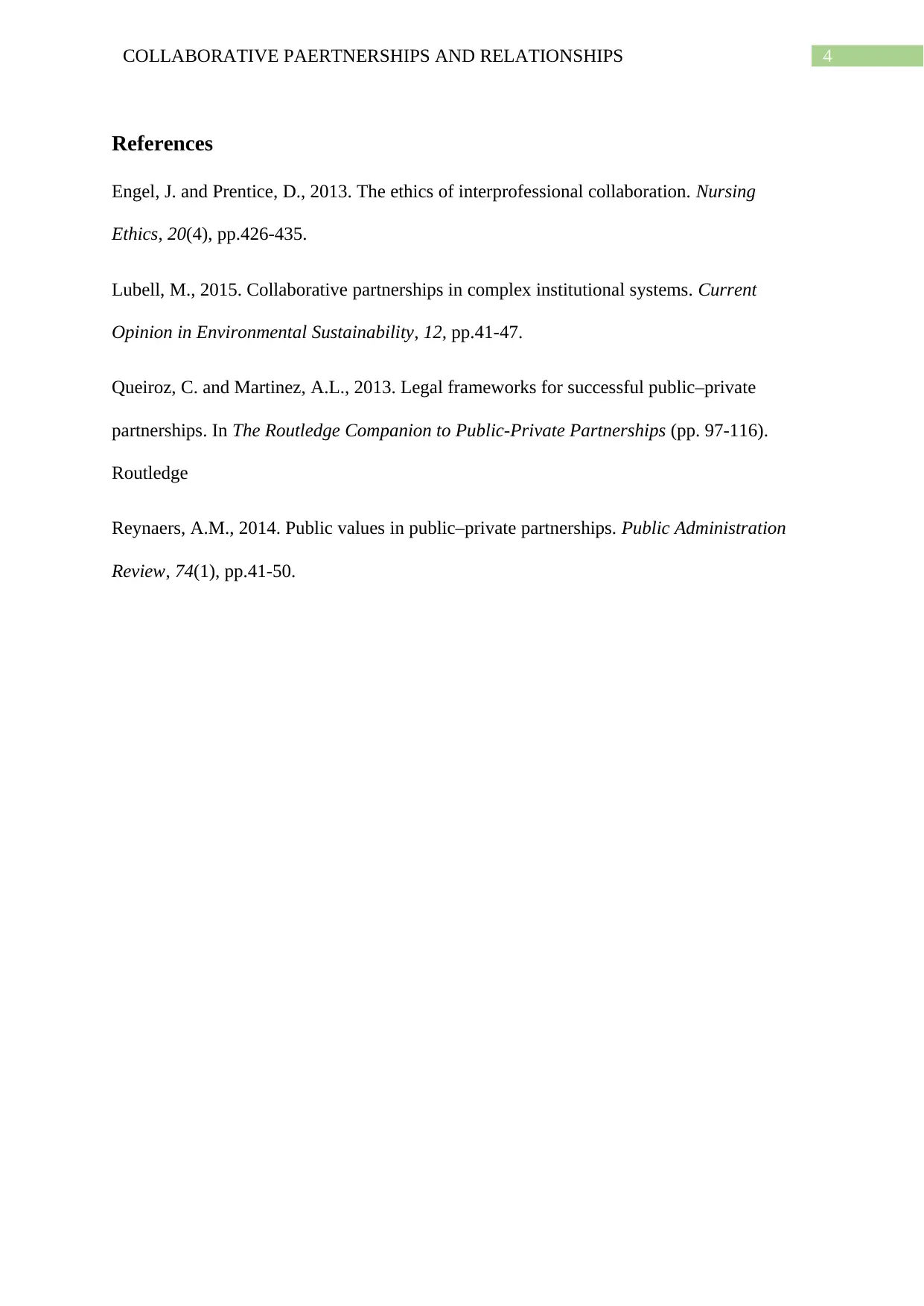
4COLLABORATIVE PAERTNERSHIPS AND RELATIONSHIPS
References
Engel, J. and Prentice, D., 2013. The ethics of interprofessional collaboration. Nursing
Ethics, 20(4), pp.426-435.
Lubell, M., 2015. Collaborative partnerships in complex institutional systems. Current
Opinion in Environmental Sustainability, 12, pp.41-47.
Queiroz, C. and Martinez, A.L., 2013. Legal frameworks for successful public–private
partnerships. In The Routledge Companion to Public-Private Partnerships (pp. 97-116).
Routledge
Reynaers, A.M., 2014. Public values in public–private partnerships. Public Administration
Review, 74(1), pp.41-50.
References
Engel, J. and Prentice, D., 2013. The ethics of interprofessional collaboration. Nursing
Ethics, 20(4), pp.426-435.
Lubell, M., 2015. Collaborative partnerships in complex institutional systems. Current
Opinion in Environmental Sustainability, 12, pp.41-47.
Queiroz, C. and Martinez, A.L., 2013. Legal frameworks for successful public–private
partnerships. In The Routledge Companion to Public-Private Partnerships (pp. 97-116).
Routledge
Reynaers, A.M., 2014. Public values in public–private partnerships. Public Administration
Review, 74(1), pp.41-50.
1 out of 5
Related Documents
Your All-in-One AI-Powered Toolkit for Academic Success.
+13062052269
info@desklib.com
Available 24*7 on WhatsApp / Email
![[object Object]](/_next/static/media/star-bottom.7253800d.svg)
Unlock your academic potential
Copyright © 2020–2025 A2Z Services. All Rights Reserved. Developed and managed by ZUCOL.





